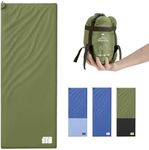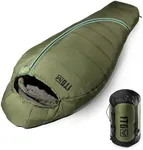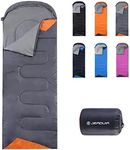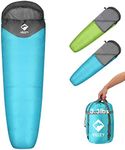Buying Guide for the Best Ultralight Sleeping Bags
Choosing the right ultralight sleeping bag is crucial for a comfortable and successful outdoor adventure. The key is to find a balance between weight, warmth, and comfort. Ultralight sleeping bags are designed to be as light as possible without compromising on essential features. When selecting an ultralight sleeping bag, consider the following key specifications to ensure you get the best fit for your needs.WeightWeight is a critical factor in ultralight sleeping bags because the primary goal is to minimize the load you carry. Ultralight sleeping bags typically weigh between 1 to 3 pounds. If you are a long-distance hiker or backpacker, aim for a sleeping bag closer to the 1-pound mark. For shorter trips or if you prioritize comfort over weight, a slightly heavier bag around 2 to 3 pounds may be acceptable. Always consider your carrying capacity and the duration of your trip when choosing the weight of your sleeping bag.
Temperature RatingThe temperature rating indicates the lowest temperature at which the sleeping bag will keep you warm. This is crucial for ensuring you stay comfortable and safe in varying weather conditions. Ultralight sleeping bags often have temperature ratings ranging from 20°F to 50°F. For summer camping or warm climates, a bag with a higher temperature rating (40°F to 50°F) is suitable. For spring and fall or cooler climates, opt for a bag with a lower temperature rating (20°F to 30°F). Consider the typical weather conditions of your camping destinations to choose the appropriate temperature rating.
Insulation TypeInsulation type affects the warmth, weight, and compressibility of the sleeping bag. There are two main types: down and synthetic. Down insulation is lighter, more compressible, and offers better warmth-to-weight ratio, making it ideal for ultralight sleeping bags. However, it can lose its insulating properties when wet. Synthetic insulation is bulkier and heavier but retains warmth even when damp and is generally more affordable. Choose down insulation for ultralight and compressibility benefits, but if you expect wet conditions, synthetic might be a better option.
ShapeThe shape of the sleeping bag affects its weight and thermal efficiency. Mummy-shaped bags are the most common for ultralight sleeping bags because they are snug and reduce the amount of air space to heat, making them more efficient at keeping you warm. They are also lighter due to less material. Rectangular bags offer more room to move but are heavier and less thermally efficient. If you prioritize weight and warmth, go for a mummy-shaped bag. If you need more space and comfort, consider a semi-rectangular shape as a compromise.
Packed SizePacked size refers to how small the sleeping bag can be compressed for storage in your backpack. This is important for saving space and making your load more manageable. Ultralight sleeping bags are designed to pack down very small, often to the size of a water bottle. When comparing packed sizes, consider the volume in liters or the dimensions provided by the manufacturer. If you have limited space in your backpack, prioritize a sleeping bag with a smaller packed size. Ensure it fits comfortably in your pack along with your other gear.
Shell MaterialThe shell material of a sleeping bag affects its durability, weight, and water resistance. Common materials include ripstop nylon and polyester. Ripstop nylon is lightweight, durable, and often treated with a water-repellent finish, making it a popular choice for ultralight sleeping bags. Polyester is also durable and can be more affordable but may be slightly heavier. Choose a shell material that balances durability and weight, and consider water resistance if you expect damp conditions. A durable shell will ensure your sleeping bag lasts through many adventures.






















